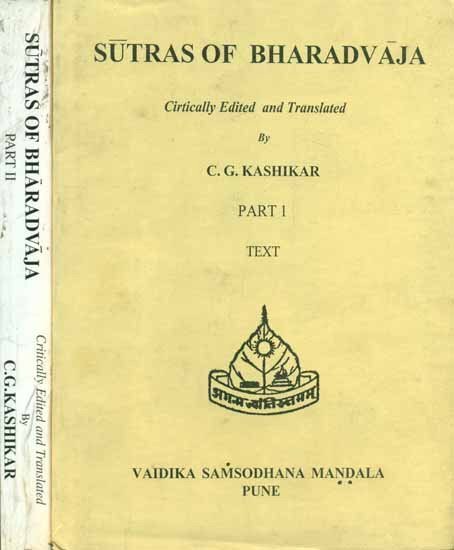Bharadvaja-srauta-sutra
by C. G. Kashikar | 1964 | 166,530 words
The English translation of the Bharadvaja-Srauta-Sutra, representing some of the oldest texts on Hindu rituals and rites of passages, dating to at least the 1st millennium BCE. The term Srautasutra refers to a class of Sanskrit Sutra literature dealing with ceremonies based on the Brahmana divisions of the Veda (Sruti). They include Vedic rituals r...
Praśna 14, Kaṇḍikā 18
1. In connection with those goblets four Stotras[1] and four Śastras[2] addressed to Aśvins together with the yājyās have been prescribed.
2. The procedure of the offering of the four sets of goblets should be regarded as explained by the goblets relating to the Saṃdhistotra.[3]
3. This much should be different: the first set of goblets should have the Hotṛ’s goblet for the principal one; the second one should bare the Maitrāvaruṇa’s goblet for the principal one; the third one should have the Brāhmaṇācchaṃsin’s goblet for the principal one; and the fourth one should have the Acchāvāka’s goblet for the principal one.[4]
4. By this the order of the Śastras and the yājyās should be regarded as explained.
5. After having responded to the reciting of the Śastras in the third pressing,[5] the Adhvaryu should recite the formula, “The Śastra has been recited for Indra.”
6. Each of the Camasins should modify the formula[6] relating to the consuming of the Soma as “...(of thee) who hast Aticchandas for thy metre and whoṇrt drunk by Aśvins....”.
7. Then[7] he should give out the call, “O Āgnīdhra, do thou fetch burning embers relating to the Upayājas.”[8]
8. The procedure up to the throwing of the enclosing sticks on the Āhavanīya fire should be similar.[9]
9. After the enclosing sticks have been thrown on the fire, the Unnetṛ should draw the Hāriyojana (into the Droṇakalaśa).
10. When be is about to take (the Soma from) the Āgrayaṇa vessel into tbe Droṇakalaśa, the Unnetṛ should give out a call (to the Maitrāvaruṇa), “Do you recite the puronuvākyā relating to the offering of Soma mixed with dhānās for harivant Indra.”
11. He should draw the vessel with the formula, “Thou art taken with a support. Thou art a bay, yoker of bays, mounter on the two bays, bearer of the bolt, impeller of Pṛśni; to thee, O god Soma, for whom the formula of the sacrifice is uttered, the Sāman is chanted and the Śastra is recited, I draw the pot connected with the bays.”[10]
12. He should mix the Soma with a large quantity of dhānās, cross over, cause the Āgnīdhra to announce and (after the latter has responded,) say (to the Maitrāvaruṇa), “Do you address a call to the Hotṛ to recite the yājyā relating to the offering of the Soma mixed with dhānās set put for harivant Indra.”
13. He should hold the pot upon his head, bestride and at the vaṣaṭ-utterance (by the Hotṛ) make the offering with the formula, “You two are bays; dhānās for the bays together with Soma for Indra, svāhā.”[11]
14. The sacrificer should follow the offering with the two verses, “Whatever fault has been mine, Agni has put it right, all-knower, he who belongs to all men.—Agni has given back the eye-sight; Indra and Bṛhaspati have given it back. Do you two, O Aśvins, replace my eyesight within the eyes.”[12]
15. With the formula, “O god Soma, I, invited, eat of thee, over whom the yajus is uttered, the Sāman is chanted, and the Śastra is recited, who hast tawny steeds, who art drunk by Indra, who hast sweetness, and who art invited,”[13] all the officiating priests, after having invited the Unnetṛ, should chew the dhānās without breaking them, while pressing them, and while making noise.[14]
Footnotes and references:
[1]:
Four Aptoryāmastotras.
[2]:
ĀśvŚS IX.11.13 ff.
[3]:
XIV.17.5.
[4]:
Āpastamba-śrauta-sūtra XIV.4.15,16 mentions this as a view of some teachers and prescribes the various sets, of goblets as respectively belonging to Agni, Indra, Viśve Devas and Viṣṇu.
[5]:
Of any Soma-sacrifice.
[7]:
The Agṅiṣṭoma which stopped at XIV.15.9 continues hereafter.
[8]:
VII.21.6.
[9]:
III.6.15.
[10]:
Taittirīya-saṃhitā I.4.28.
[11]:
Taittirīya-saṃhitā I.4.28.
[12]:
Taittirīya-saṃhitā III.2.5.4.
[13]:
Taittirīya-saṃhitā III.2.5.4.
